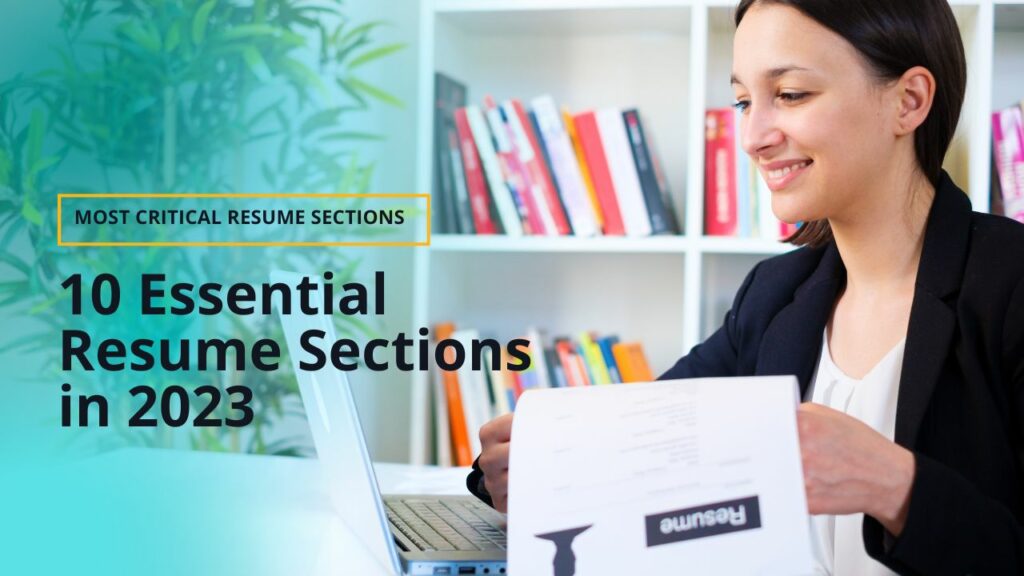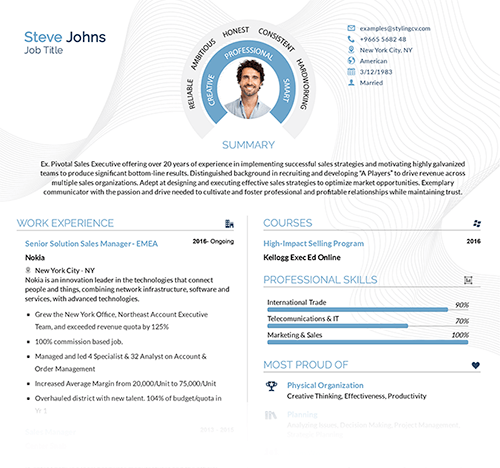
Secciones de un currículum Hay 5 secciones principales del currículum que siempre debe incluir: un encabezado, un resumen u objetivo del currículum, su experiencia laboral, la información sobre sus estudios y una sección de habilidades...
Ayuda para currículos - 10 secciones esenciales del currículum vitae en 2023
Obtenga su currículum gratis ahora10 secciones esenciales del currículum vitae en 2023
Hay 5 secciones principales del currículum que siempre debe incluir: un encabezamiento, un resumen u objetivo del currículum, su experiencia laboral, la información sobre sus estudios y una sección de habilidades. Además, hay algunas áreas alternativas que puede incluir si le sobra espacio. ¿Sabía que sólo alrededor del 25% de los...
albahaca
Especialista en contenidos


Hay 5 secciones principales del currículum que siempre debe incluir: un encabezamiento, un resumen u objetivo del currículum, su experiencia laboral, la información sobre sus estudios y una sección de habilidades. Además, hay algunas áreas alternativas que puede incluir si le sobra espacio.
¿Sabía que sólo alrededor del 25% de los currículos enviados consiguen pasar los sistemas de seguimiento de candidatos y llegar a los escritorios de los reclutadores? Puede que piense que ha enumerado sus mejores cualidades y que tiene muchas posibilidades de ser contratado, pero puede que su currículum ni siquiera llegue a los reclutadores si no incluye los elementos que están buscando. Esto significa que si está buscando trabajo activamente y enviando sus currículos a diferentes organizaciones, debe asegurarse de que está adoptando las mejores prácticas que harán que su currículo destaque.
Al fin y al cabo, es una industria competitiva y sólo los mejores de los mejores llegan a los procesos finales de contratación. Con un currículum bien redactado y estructurado, puede asegurarse de llegar a la siguiente fase y de que su currículum no acabe en alguna carpeta de basura.
El truco para un currículum bien diseñado consiste en centrarse en las 10 secciones principales del currículum. En este artículo, hablaremos de cómo redactar cada sección del currículum, qué detalles incluir u omitir y la importancia de cada paso. También hablaremos de cómo formatear y estructurar su currículum puede mejorar sus posibilidades de llamar la atención.
Empecemos.
Secciones principales del currículum en las que debe centrarse
Piense en su currículum como si fuera un menú. ¿Sabe cómo cada sección del menú muestra una categoría de comida diferente y le facilita la tarea de finalizar su pedido? Así es como funciona también un currículum. Sólo que, en lugar de categorías de comida, destaca sus cualificaciones y experiencias.
Cada sección del currículum representa un aspecto único de usted. Desde los detalles personales y los objetivos hasta el conjunto de habilidades y experiencias, las secciones del currículum le ayudan a organizar su información de forma ordenada.
He aquí algunos de los componentes más cruciales de un currículum que no puede descuidar:
1. Sección de contacto
La sección de contacto es lo primero que deben ver los reclutadores cuando abren su currículum. Esto significa que tiene que estar en la parte superior de su currículum.
Probablemente se pregunte por qué es necesario colocar la sección de contactos justo al principio. Después de todo, ¿no son sus habilidades y experiencia las verdaderas estrellas de su currículum? ¿Seguro que hay que destacarlas primero?
Bueno, aunque se trata de detalles importantes que afectan directamente al proceso de toma de decisiones, es la información de contacto la que utilizan los reclutadores para ponerse en contacto con los solicitantes. Si esta información falta en su currículum o es difícil de encontrar, ¡lo más probable es que no reciba esa llamada o ese correo electrónico que estaba esperando!

Qué incluir:
Asegúrese de que en su currículum figuran los siguientes detalles:
- Nombre y apellidos
- Dirección de correo electrónico
- Número de teléfono
- Perfil de LinkedIn (opcional)
- Ubicación (ciudad y estado)
No tiene por qué incluir la dirección de su domicilio en su currículum. También puede optar por incluir u omitir enlaces a sus cuentas de redes sociales u otros canales en función del puesto al que opte. Por ejemplo, si solicita un puesto de marketing digital y tiene su blog o sitio web, es recomendable que lo incluya en la sección de contacto, ya que reflejará sus habilidades.
Toda la información que incluya en la sección de contacto debe ser profesional. Si aún no tiene una dirección de correo electrónico profesional, cree una nueva utilizando el formato firstname.lastname@gmail.com.
2. Objetivo o resumen del currículum
La siguiente sección del currículum es el objetivo del currículum o el resumen del currículum. Se utilizan para esbozar brevemente sus metas laborales. Tenga en cuenta que un objetivo de currículum no es lo mismo que un resumen de currículum.
El objetivo de un currículum es una introducción de 2 a 3 líneas sobre sus aptitudes profesionales y objetivos de carrera, y pretende esbozar por qué es usted un buen candidato para el puesto. Un resumen del currículum es un esbozo igualmente conciso de su experiencia laboral y pretende destacar sus mayores logros y habilidades profesionales.
Qué incluir:
- Un currículum objetivo es más adecuado para las personas que buscan cambiar de profesión. También es útil para recién licenciados o personas con poca experiencia laboral.
- Se recomienda un resumen del currículum vitae a las personas que tengan una experiencia laboral significativa y aspiren a puestos de alto nivel.
Elija la que mejor se adapte a sus necesidades de empleo.
3. Experiencia laboral
A continuación, su currículum necesita una sección en la que destaque su experiencia laboral. Éste es sin duda uno de los componentes más críticos de su currículum y es evaluado cuidadosamente por los reclutadores. Resume sus experiencias profesionales pasadas y actuales y sirve como registro de su historial laboral. No es necesario que añada en esta sección todos y cada uno de los trabajos que ha tenido. Intente que sea lo más relevante posible, mencionando las experiencias que estén más estrechamente relacionadas con el puesto que solicita.
Por supuesto, esto depende de sus años de experiencia en sí. Por ejemplo, si es un recién licenciado o lleva pocos años trabajando, puede incluir sus experiencias en prácticas y mencionar los trabajos a tiempo parcial que hizo durante la universidad. En cambio, si tiene más de 10 años de experiencia, debería incluir sólo los empleos y puestos más significativos.
Qué incluir:
Para cada puesto mencionado, debe mencionar claramente el:
- Cargo/designación
- Nombre de la empresa
- Ubicación
- Fechas de empleo
- Breve descripción de responsabilidades y tareas
- Principales logros
Asegúrese de utilizar el tiempo pasado al redactar las descripciones de los empleos desempeñados anteriormente. Utilice el tiempo presente para la experiencia laboral actual mencionada.
4. Calificaciones académicas
La cuarta sección del currículum a la que debe prestar atención es la de educación. Esto da a los reclutadores una idea de su formación académica y destaca cualquier premio o logro que pueda haber recibido durante sus años en la universidad o en la escuela.

Qué incluir:
Una vez más, las cualificaciones académicas que enumere dependerán de su experiencia y del puesto que solicite. Un recién graduado universitario puede mencionar sus diplomas y logros de bachillerato. Un profesional con más experiencia puede limitarse a incluir los datos de sus estudios superiores. En cualquier caso, debe mencionar los:
- Título/diploma
- Nombre del programa
- Nombre del centro educativo
- Especialidad (opcional)
- Premios recibidos (opcional)
- GPA (opcional)
5. Habilidades
La sección de habilidades de su currículum es su oportunidad para enumerar todas las habilidades relevantes y específicas que posee. Esta sección del currículum ofrece a los reclutadores una visión rápida de sus habilidades y les ayuda a identificar si posee las aptitudes necesarias para el puesto. Enumere sus habilidades en columnas con viñetas para una mayor legibilidad.
Qué incluir:
La elección de sus competencias dependerá del sector al que se dirija. Deberá incluir:
- Conocimientos técnicos relevantes para el puesto
- Habilidades universales que puedan utilizarse en el trabajo (por ejemplo, habilidades informáticas, de marketing digital, de Photoshop, etc.)
- Habilidades blandas que mejor encajen con el puesto (por ejemplo, habilidades de pensamiento crítico, de liderazgo, de comunicación, etc.)
Utilice las palabras clave adecuadas para optimizar su sección de habilidades y permitir que los posibles empleadores conozcan sus áreas de especialización.
Secciones opcionales del currículum que puede incluir
Aparte de los componentes obligatorios destacados anteriormente, también puede incluir información adicional en su currículum. Sin embargo, asegúrese de no añadir estos detalles porque sí. Si la información adicional es irrelevante o no añade valor a su currículum, es mejor excluirla.
Éstas son las secciones opcionales del currículum en las que puede centrarse:
6. Premios y logros
¡No está de más alardear un poco de sus logros! Si ha recibido algún premio, galardón o certificación que no pudo incluir en sus secciones de trabajo y educación, esta es su oportunidad de destacarlos. Estos pueden incluir:
- Publicaciones
- Honores
- Reconocimiento internacional
- Certificaciones en línea/fuera de línea
- Premios y medallas
Asegúrese de mencionar el nombre de cada premio junto con la fecha en que lo recibió. También puede incluir una breve descripción del mismo.

7. Idiomas
Le sorprendería saber lo mucho que valoran los reclutadores a los candidatos que dominan varios idiomas. Se trata de una habilidad especialmente codiciada si el puesto requiere un trabajo en red a nivel mundial o si la descripción del puesto menciona específicamente las preferencias lingüísticas.
Si habla más de un idioma con fluidez, incluya una sección de idiomas. Mencione también su nivel de fluidez (por ejemplo, principiante, intermedio o avanzado) junto al idioma.
8. Trabajo voluntario
A los reclutadores les encantan los candidatos que han participado en algún tipo de servicio comunitario o trabajo voluntario. ¿Qué mejor manera de demostrar su pasión por devolver algo a la comunidad que enumerando sus experiencias de voluntariado en su currículum? Esto es especialmente útil si el trabajo comunitario en cuestión coincide con las metas y los objetivos de la empresa o enlaza bien con el puesto que solicita. También puede contar como experiencia laboral si es usted un recién licenciado con poca experiencia profesional.
Al enumerar sus experiencias, no olvide incluir las:
- Nombre de la organización o entidad benéfica con la que ha trabajado
- Duración del trabajo
- Ubicación
- Tareas y actividades relevantes en las que ha participado
- Principales logros
9. Aficiones
¿Le sorprende ver esto? Permítanos explicárselo.
Esta sección del currículum es una forma de mostrar sus intereses y actividades a los reclutadores, dándoles una idea de su personalidad. Las cosas que le gustan dicen mucho de usted, e incluir aficiones relevantes e interesantes puede causar una buena impresión a los reclutadores que revisen su currículum.
Por supuesto, esto no significa que enumere todas y cada una de sus aficiones. Sea breve e interesante, e intente incluir aficiones que se correspondan con sus aptitudes duras o blandas. Para los recién licenciados, ésta es una forma creativa de rellenar el espacio en blanco de sus currículos. Y oiga, ¡una afición interesante puede convertirse en tema de conversación durante una entrevista!

10. Actividades y proyectos extracurriculares
Esta sección del currículum es más relevante para los recién licenciados o los empleados jóvenes con poca experiencia. Destaca sus actividades extracurriculares y proyectos no relacionados con el trabajo, mostrando a los reclutadores que ha hecho algo más que darle a los libros en la universidad. También demuestra que le gusta mantenerse comprometido y encontrar nuevas formas de lograr un equilibrio entre la vida laboral y personal.
Puede utilizar esta sección del currículum para mencionarlo:
- Clubes o sociedades de los que forma/formó parte
- Conferencias, talleres o seminarios a los que haya asistido
- Negocios paralelos (por ejemplo, trabajo autónomo, empresas desde casa, etc.)
- Publicaciones para las que ha escrito
- Blogs personales
Consejos adicionales para estructurar un currículum
Ahora que sabe lo que tiene que ir en su currículum y cómo incorporar la información pertinente según su nivel profesional, hablemos de cómo debe estructurar su documento.
La estructuración del currículum es extremadamente importante, ya que le ayuda a que su información tenga un aspecto presentable. Puede que usted sea la persona más cualificada para el puesto y que incluya justo lo necesario en su currículum, pero si el documento tiene un aspecto desordenado o desordenado, es posible que los reclutadores no lo lean hasta el final. De hecho, puede que se decanten por otro candidato porque su currículum era más presentable que el suyo aunque ambos tengan aptitudes similares.
Esto es lo que tiene que hacer:
- Mantenga su currículum en una página
- Adaptar cada detalle según el papel
- Utilice líneas o espacios en blanco para separar cada sección del currículum
- Utilice estilos y tamaños de letra fáciles de leer y manténgalos coherentes
- Formatee los encabezados de sección y el texto bajo ellos

PREGUNTAS FRECUENTES
1- ¿necesita un objetivo en su curriculum vitae 2023
En el competitivo mercado laboral de hoy en día, no necesita una sección de "Objetivos" en su currículum. Muchas empresas ya no valoran los objetivos del currículum, que ocupan un espacio en la parte superior de su currículum que estaría mejor empleado en otras partes como una declaración de resumen de su carrera.
2- qué secciones incluir en un currículum
- Normalmente, un currículum tendrá las secciones que se indican a continuación:
- Encabezamiento. Ponga su nombre, dirección completa, número de teléfono y correo electrónico en el cuerpo. ...
- Propósito profesional (opcional) Se trata de una declaración o cláusula que hace hincapié en sus objetivos y logros.
- Resumen de cualificaciones (opcional) (opcional) La educación, la experiencia y las referencias son necesarias.
3- ¿cómo enumerar las habilidades en un currículum 2023?
- Enumere todas sus habilidades destacadas.
- Reste las competencias menos necesarias.
- Eche un vistazo a la descripción del puesto.
- Clasifique las balas.
- Dé ejemplos.
4- ¿qué significa objetivo en un cv?
Una declaración de objetivos clara y centrada en el puesto destaca el valor que puede aportar y las necesidades que puede satisfacer. Puede incluir en su objetivo una descripción sucinta de las capacidades y cualificaciones que aportará a un puesto.
Su plataforma de creación de currículos
¿Tiene problemas para crear el currículum perfecto? ¡Para eso estamos nosotros!
StylingCV ayuda a los solicitantes y candidatos a dar un paso más hacia el empleo de sus sueños proporcionándoles las herramientas necesarias para crear CV y currículos impresionantes. Ofrecemos plantillas de currículum personalizables para adaptarnos a las necesidades de cada solicitante de empleo y ayudarle a clasificarse para la entrevista de trabajo. También puede utilizar nuestro Creador de currículos para crear el perfil perfecto.
Cree hoy mismo su cuenta básica para probarlo gratis y diseñar su currículum.
Artículos relacionados
Etiquetas:
Construya su currículum en 10 minutos
Utilice plantillas de currículum profesionales probadas en el terreno que siguen las "reglas del currículum" exactas que buscan los empleadores. Crear mi currículum
CONSTRUIR MI CURRICULUM VITAE AHORA![List of 100 Best Words to Describe Yourself [Adjectives & More] Lista de las 100 mejores palabras para describirse a sí mismo [Adjetivos y más]](https://assets.stylingcv.com/wp-content/uploads/2021/09/Words_to_Describe_Yourself.png)




